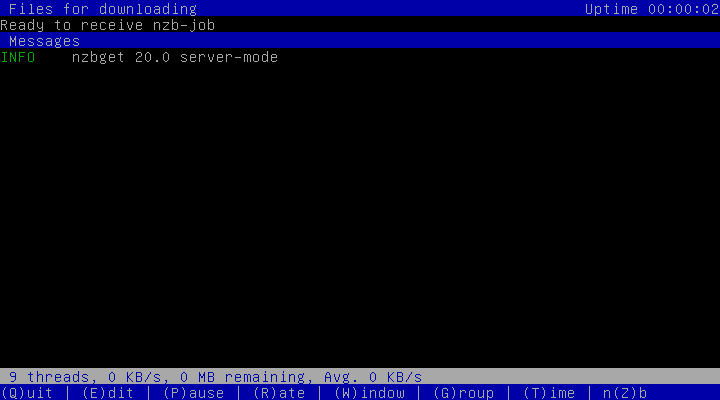

- CONFIGURE SONARR TO USE NZBGET INSTALL
- CONFIGURE SONARR TO USE NZBGET MANUAL
- CONFIGURE SONARR TO USE NZBGET DOWNLOAD
(Which will also make Kodi wait for the network to be up before loading) NZBGet’s ‘Add NZB Files to Download’ dialogue box. Network-online.target will cause it to wait until the network is actually up and running (valid IP address received by DHCP and link active) but it will only wait if you enable the connman-wait-for-network service as well. Click this button to add an NZB to NZBGet. Network.target will cause it to start after our network manager (connman) starts, but potentially before the network is actually up (doesn’t usually matter for daemons that bind to all interfaces though) and will also cause it to be shut down before the network goes down on reboot/shutdown. You should either have After = network.target Set to nzbdget, and change LOCALHOST to yourNASIP (so, make sure your nas has a static IP in your router setttings) Do not use the internal docker IP 172.XX.X as this is not static.# This will load nzbget only after setting up the networkĭaemonAfter is not a valid unit directive as far as I know. Set up sonarr via your webbrowser setup the dowloadclient in sonarr via settings->downloadclient Access and log in to your Sonarr instance using the credentials you set during installation Go to Settings Make sure that advanced settings are set to Shown. PGIDđ00 (it is 100 if your dockeruser is the first user in omv, if not then log into your nas and type id username for the correct number) tv -> /srv/dev-disk-by-label-YOURDRIVENAME/YOURTVSHOWSFOLDER downloads -> /srv/dev-disk-by-label-YOURDRIVENAME/YOURDOWNLOADSFOLDER Select the 'News-Servers' option from the side menu. From the start page, select Settings from the top.
CONFIGURE SONARR TO USE NZBGET INSTALL
Install the client, changing any directory settings desired. We strongly recommend using a stable release of the client. the name is transmission and the host is the IP of the machine. So try the hostname of the system where nzbget runs.

Since you run the lsio sonarr docker, your nzbget runs somewhere else, outside the sonarr container.
CONFIGURE SONARR TO USE NZBGET DOWNLOAD
you dont enter any kickass info into the download client setup for transmission. Unless you have a Frankenstein docker container which has both sonarr and nzbget, the hostname will not be localhost. Host If NZBGet is installed on the same device as Radarr. Enter the details of your NZBGet installation. config -> /home/dockeruser/.config/sonarr You’ll find the latest version of NZBGet available from their website. The settings you enter into Transmission settings in Sonarr are the ones to connect to your Transmission client (the one you have running on your computer). If that is not the case yet, see the tutorial installing NZBGet Windows. Then add another container for sonarr, follow the same steps, but use: Other sections, like network etc can stay at the default settings.ĭone! configure nzbget via your webbrowser SONARR Sonarr automatically removes your download entries (history) in your client (uTorrent, BitTorrent, Nzbget, etc.). Then go to restart policy, set to unless stopped In addition to auto-downloads, you can also use Sonarr to manually find releases and send them directly to your download client. This seems to only happen when NZBGetVPN is running. Install Sonarr and NZBGet on your Raspberry Pi HTPC Guides has very detailed guides about installing and setting up both Sonarr and NZBGet. The Cpu usage remained spiked for about 5 minutes before returning to normal.

Name: PGID value: 100 (it is 100 if your dockeruser is the first user in omv, if not then ssh into your nas and type id username for the correct number) To make the CPU spike I started NZBGetVPN and let it run for about 4 minutes, it then spiked and I paused NZBGetVPN.

CONFIGURE SONARR TO USE NZBGET MANUAL
In portainer click on local, containers, +add container, then fill in the following:Ĭlick on Manual network port publishing, then +publish a new network portįor container fill in /config then click bind and fill in /home/dockeruser/.config/nzbget for the volumeĭo the same for /downloads -> dev/dev-disk-by-label-YOURDRIVENAME/YOURDOWNLOADSFOLDER Log into the omv user interface, go to the omv extras tab, click on docker and then on docker->install, and portainer->installĬlick on open web for the portainer interface Make a config folder in your dockerusers home directory, like /home/dockeruser/.config/nzbget I start with making a user specific to docker, this is the first user in my omv users.


 0 kommentar(er)
0 kommentar(er)
